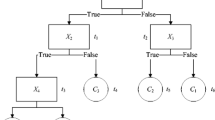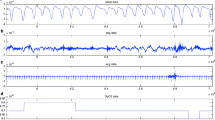Abstract
In this paper, we have compared the classifier algorithms including C4.5 decision tree, le artificial neural network (ANN), artificial immune recognition system (AIRS), and adaptive neuro-fuzzy inference system (ANFIS) in the diagnosis of obstructive sleep apnea syndrome (OSAS), which is an important disease that affects both the right and the left cardiac ventricle. The goal of this study was to find the best classifier model on the diagnosis of OSAS. The clinical features were obtained from Polysomnography device as a diagnostic tool for obstructive sleep apnea in patients clinically suspected of suffering this disease in this study. The clinical features are arousals index, apnea–hypopnea index (AHI), SaO2 minimum value in stage of rapid eye movement, and percent sleep time in stage of SaO2 intervals bigger than 89%. In our experiments, a total of 83 patients (58 with a positive OSAS (AHI > 5) and 25 with a negative OSAS such that normal subjects) were examined. The decision support systems can help to physicians in the diagnosing of any disorder or disease using clues obtained from signal or images taken from subject having any disorder. In order to compare the used classifier algorithms, the mean square error, classification accuracy, area under the receiver operating characteristics curve (AUC), and sensitivity and specificity analysis have been used. The obtained AUC values of C4.5 decision tree, ANN, AIRS, and ANFIS classifiers are 0.971, 0.96, 0.96, and 0.922, respectively. These results have shown that the best classifier system is C4.5 decision tree classifier on the diagnosis of obstructive sleep apnea syndrome.



Similar content being viewed by others
References
American Academy of Sleep Medicine Task Force, Sleep-related breathing disorders in adults: recommendations for syndrome definition and measurement techniques in clinical research. Sleep 22:5667–689, 1999.
Kaltz, E. S., Lutz, J., Black, C., and Marcus, C. L., Pulse Transit Time as a measure of arousal and respiratory effort in children with sleep-disorder breathing. Pediatr. Res 53:4580–588, 2003, April 1.
Al-Ani, T., Hamam Y., Novak, D., Pozzo mendoza, P. T., Lhotska, L., Lofaso, F., Isabey, D., and Fodil, R., Noninvasive automatic sleep apnea classification system. BioMedSim'05, Linköping, Sweden, May 26–27, 2005.
Al-Angari, H. M., and Sahakian, A. V., Use of sample entropy approach to study heart rate variability in obstructive sleep apnea syndrome. IEEE Trans. Biomed. Eng 54(10):1900–1904, 2007.
del Campo, F., Hornero, R., Zamarrón, C., Abasolo, D. E., and Álvarez, D., Oxygen saturation regularity analysis in the diagnosis of obstructive sleep apnea. Artif. Intell. Med 37:111–118, 2006.
Kwiatkowska, M., and Schmittendorf, E., Assessment of obstructive sleep apnea using pulse oximetry and clinical prediction rules: a fuzzy logic approach. BMT, Nuremberg, Germany, Sept 14–17 2005.
Rechtschaffen, A., and Kales, A., A manual of standardized terminology, techniques and scoring system for sleep stages of human subjects. National Institutes of Health Publication No. 204. US Government-Printing Office, Washington, DC, 1979.
American Thoracic Society consensus statement, Indications and standards for cardiopulmonary sleep statement. Am Rev. Respir Dis 139:559–568, 1989.
American Academy of Sleep Medicine Task Force, Sleep-related breathing disorders in adults: Recommendations for syndrome definition and measurement techniques in clinical research. Sleep 22:667–689, 1999.
Douglas, N. J., Thomas, S., and Jan, M. A., Clinical value of polysomnography. Lancet 339:347–50, 1992.
Mitchell, M. T., Machine learning. McGraw-Hill, Singapore, 1997.
Quinlan, J. R., Induction of decision trees. Mach. Learn 1:81–106, 1986.
Polat, K., and Güneş, S., The effect to diagnostic accuracy of decision tree classifier of fuzzy and k-NN based weighted pre-processing methods to diagnosis of erythemato-squamous diseases. Digit. Signal Process 16(6):922–930, 2006.
Watkins, A., AIRS: a resource limited artificial immune classifier, Master Thesis. Mississippi State University, Mississippi, 2001.
Polat, K., Şahan, S., and Güneş, S., A new method to medical diagnosis: Artificial Immune Recognition System (AIRS) with fuzzy weighted pre-processing and application to ECG Arrhythmia (2005). Expert Syst. Appl 31(2):264–269, 2006.
Jang, J.-S. R., ANFIS: Adaptive-network-based fuzzy inference system. IEEE Trans. Syst. Man Cybern 23(3):665–685, 1993.
Jang, J.-S. R., Self-learning fuzzy controllers based on temporal backpropagation. IEEE Trans. Neural Netw 3(5):714–723, 1992.
Polat, K., and Güneş, S., A hybrid medical decision making system based on principles component analysis, k-NN based weighted pre-processing and adaptive neuro-fuzzy inference system. Digit. Signal Process 16(6):913–921, 2006.
Fawcett, F., An introduction to ROC analysis. Pattern Recogn. Lett 27(8):861–874, 2005.
Liu, Y., and Zheng, Y. F., One-against-all multi-class SVM classification using reliability measures, Neural Networks, 2005. IJCNN ‘05. Proceedings. 2005 IEEE International Joint Conference on Volume 2, 31 July–4 Aug. 2:849–854, 2005.
Acknowledgements
This study has been supported by Scientific Research Project of Selcuk University. (project no. 05401069).
Author information
Authors and Affiliations
Corresponding author
Rights and permissions
About this article
Cite this article
Polat, K., Yosunkaya, Ş. & Güneş, S. Comparison of Different Classifier Algorithms on the Automated Detection of Obstructive Sleep Apnea Syndrome. J Med Syst 32, 243–250 (2008). https://doi.org/10.1007/s10916-008-9129-9
Received:
Accepted:
Published:
Issue Date:
DOI: https://doi.org/10.1007/s10916-008-9129-9




